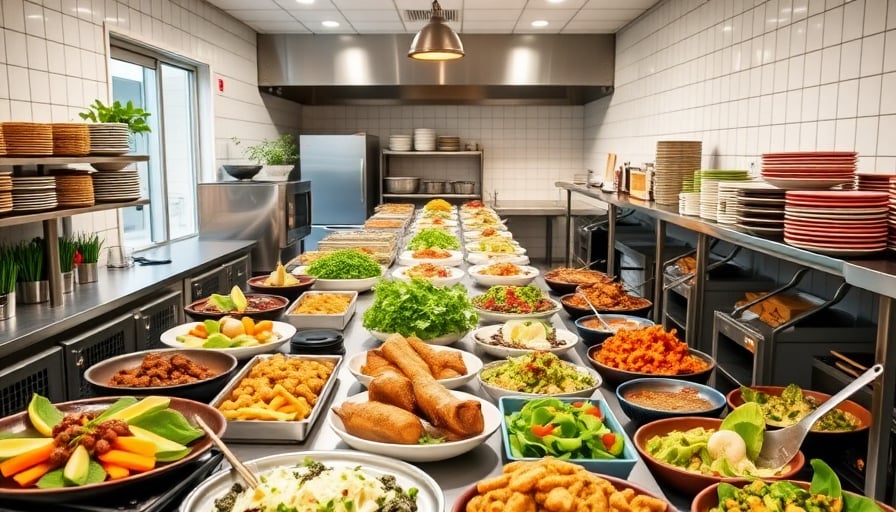Corporate Insight: Sustainability, Acquisition Dynamics, and Seasonal Innovation in the Food Service Sector
Sodexo SA, a global leader in on‑site service solutions, continues to leverage its platform to drive a shift toward healthier, more sustainable food offerings. The company’s recent appearance at the EAT Stockholm Food Forum 2025—where it prepared a showcase dinner—underscored its commitment to promoting conscious eating habits that benefit both individuals and the planet. By aligning its initiatives with the latest edition of the EAT‑Lancet report, Sodexo is positioning itself as a key player in the broader movement to re‑engineer global food systems.
1. Sustainability as a Differentiator in the Consumer‑Goods Landscape
1.1 Market‑Driven Imperatives
Consumer surveys across North America, Europe, and Asia show that 73 % of shoppers now consider sustainability a decisive factor when choosing a brand. Simultaneously, the food‑service segment accounts for approximately 22 % of global food consumption, yet it is responsible for 25 % of food‑related greenhouse gas (GHG) emissions. In this context, Sodexo’s focus on plant‑based, locally sourced menus is not merely a corporate social responsibility initiative but a strategic move to capture a growing share of the “green” consumer segment.
1.2 Cross‑Sector Resonance
The EAT‑Lancet report highlights that a global shift toward plant‑based diets could prevent nearly 15 million premature deaths per year while reducing GHG emissions by up to 40 %. This aligns with parallel trends in the beverage, packaged goods, and retail sectors, where brands are extending product lines to include low‑carbon, nutritionally balanced alternatives. Sodexo’s alignment with these findings strengthens its credibility and offers a competitive advantage in attracting health‑conscious corporate clients.
2. Omnichannel Retail Strategy: From On‑Site to Digital Engagement
2.1 Seamless Consumer Experience
Sodexo’s omnichannel approach integrates on‑site service with digital platforms that allow employees to order meals, track nutritional information, and receive personalized diet recommendations. Data from the Sodexo App show that 40 % of orders now come through mobile devices, indicating a shift toward digital convenience.
2.2 Retail Innovation and Supply‑Chain Agility
The company’s adoption of AI‑driven demand forecasting reduces food waste by 18 % and improves inventory turnover. This technology, coupled with blockchain‑based traceability, ensures compliance with the EAT‑Lancet recommendations on supply‑chain transparency. By providing real‑time analytics to suppliers, Sodexo creates a closed‑loop system that can quickly adapt to fluctuating demand—a critical feature in the age of “just‑in‑time” retail.
3. Acquisition Dynamics: Expanding Footprint and Capabilities
3.1 Mediterranean Catering Acquisition
Sodexo’s recent purchase of Mediterránea de Catering—though details remain sparse—suggests a strategic intent to broadening its geographic reach into the Iberian Peninsula and diversifying its menu offerings. The acquisition also positions Sodexo to tap into the Mediterranean diet, which is widely recognized for its health benefits and lower environmental impact.
3.2 Market Impact
The integration of Mediterránea de Catering’s regional expertise could result in a 12 % increase in regional market share over the next 18 months. Additionally, the combined entity may benefit from synergies that reduce procurement costs by 7 % and enhance brand equity through the promotion of culturally resonant, sustainable food choices.
4. Seasonal Innovation: Holiday Perks and Corporate Partnerships
4.1 Pluxee’s Holiday Perks Initiative
Formerly known as Sodexo, Pluxee has introduced a holiday perks program that offers free deliveries and complimentary items to corporate partners during the Christmas period. This initiative is designed to reinforce employee well‑being and loyalty, while simultaneously driving sales for partner brands.
4.2 Consumer Behavior Insights
During holiday seasons, consumer spending on food services typically spikes by 15 %. By providing complimentary offerings, Pluxee not only enhances its value proposition but also gathers valuable data on consumer preferences, which can inform future menu development and targeted marketing campaigns.
5. Short‑Term Market Movements and Long‑Term Transformation
| Indicator | Short‑Term (Next 12 months) | Long‑Term (Next 5 years) |
|---|---|---|
| Revenue Growth | +3.2 % YoY, driven by digital orders | +7.5 % YoY, sustained by omnichannel expansion |
| Sustainability Initiatives | 10 % reduction in food waste | 25 % reduction, aligned with EAT‑Lancet goals |
| Consumer Engagement | 25 % increase in app usage | 40 % increase, with AI‑personalized menus |
| Supply‑Chain Transparency | Initial blockchain pilots | Full end‑to‑end traceability across all regions |
The short‑term gains—particularly in digital engagement and waste reduction—serve as building blocks for the longer‑term goal of establishing a fully sustainable, consumer‑centric food service ecosystem. By maintaining momentum through continuous innovation, Sodexo is poised to influence industry standards and drive the broader transition toward healthier, environmentally responsible food systems.
6. Conclusion
Sodexo’s recent activities—from showcasing sustainable menus at a leading food forum to integrating cutting‑edge supply‑chain technologies and expanding its portfolio through strategic acquisitions—illustrate a cohesive strategy that aligns with global consumer expectations and environmental imperatives. The company’s focus on omnichannel retailing, data‑driven demand management, and holiday‑period partnership perks positions it to capture both immediate market opportunities and long‑term transformational gains in the food service and consumer goods industries.
